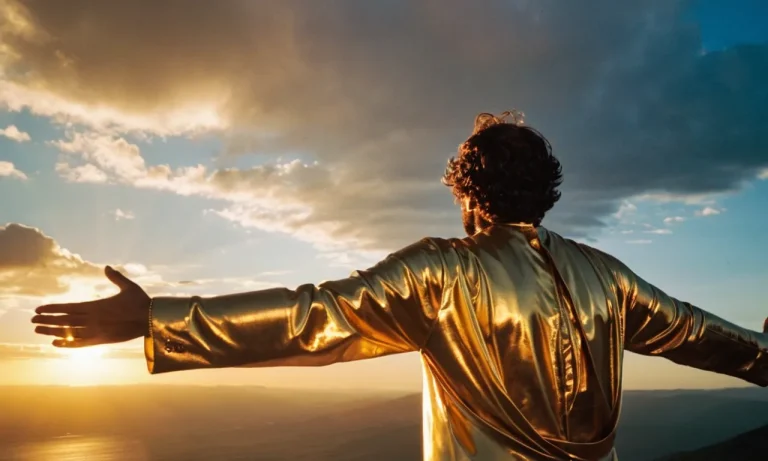Dionysus: The Greek God Of Harvest, Wine, And Festivity
The ancient Greek gods ruled over many parts of daily life, and wine was no exception. If you’re looking for a quick answer, the Greek god most closely associated with the harvest, wine, and festivity is Dionysus.
This article will examine Dionysus in depth – his origins, myths, symbols, festival celebrations, and more. With over 3000 words, you’ll come away with extensive knowledge of this joyful, intriguing god of the grape harvest.
The Origins and Family of Dionysus
Dionysus’s Birth and Upbringing
Dionysus has a unique birth story compared to other Greek gods. While most gods were born from only one parent, Dionysus was the son of Zeus, king of the gods, and Semele, a mortal woman. This rare mixed parentage explains why Dionysus embodies both divine and earthly qualities.
According to legend, Zeus fell in love with the beautiful Semele and visited her in secret since his wife Hera despised his cheating. When Semele was pregnant, Hera tricked her into asking Zeus to reveal his true lightning-bolt wielding form, which was too much for any mortal to behold.
Semele perished, but Zeus was able to rescue the unborn Dionysus and sewed him into his thigh until he reached term. Another version claims Dionysus was gestated fully in Zeus’s thigh!
After his unusual double birth, Dionysus was raised on earth by the nymphs of Mount Nysa. The god of wine grew up wandering through orchards and vineyards, learning the secrets of cultivating grapes and olives. Unlike warlike gods like Ares, Dionysus preferred dancing, music, and drinking wine.
His pastoral upbringing nurtured his generous and joyful personality.
Dionysus’s Appearance and Personality
In ancient art, Dionysus was depicted as an attractive, beardless youth overflowing with vigor and enthusiasm. He often wore a crown of ivy and carried a fennel staff wreathed in vine leaves called a thyrsus. Dionysus was associated with panthers, leopards, and tigers.
He was usually accompanied by a wild, drunken entourage of satyrs, maenads, and nymphs.
As the god of the grape harvest, fertility, winemaking, and ecstatic ritual, Dionysus was one of the most beloved Greek gods. Despite being raised on earth, Dionysus exhibited great power. He could strike men with madness or fill them with divine ecstasy.
However, Dionysus was better known for bringing joy to mortals rather than punishing them. His festivals honored the exuberance of life through drinking, dancing, feasting, and theater. Unlike the war gods, Dionysus promoted creativity, laughter, and community.
While the Greeks feared the wrath of Zeus, they adored Dionysus for allowing them to achieve transcendence and lose their inhibitions through wine and revelry. Dionysus’s cult thrived as people everywhere sought divine escape through this god’s earthly blessings.
Key Myths of Dionysus
Punishment of King Midas
The tale of King Midas and his famous “golden touch” is one of the most well-known myths involving the god Dionysus. As the myth goes, Dionysus was wandering through a forest in Phrygia accompanied by his usual raucous entourage of satyrs and maenads.
The group stumbled upon an old man who had gotten lost and helped him find his way back to the city. This old man turned out to be the king of Phrygia, Midas. To thank Dionysus for his kindness, Midas invited the wine god and his wild followers to enjoy unlimited food and wine at his palace for ten days and nights.
When it was time for Dionysus to depart, he offered to grant Midas any wish as a final gift of gratitude. Much to Dionysus’s dismay, the greedy king wished that everything he touched would turn to gold. Though Dionysus knew this was a foolish desire, he had no choice but to grant Midas his wish.
At first Midas was delighted as he turned pieces of furniture, statuary, and even chunks of the palace itself into solid gold. But soon he realized that his new golden touch was in fact a curse. When he touched food, it turned hard and inedible.
Worst of all, when he hugged his young daughter, she instantly transformed into a lifeless golden statue.
Repenting and desperate, Midas begged Dionysus to take back his cursed gift. Taking pity on him, Dionysus told Midas to bathe in the river Pactolus to wash away the golden touch. Midas obeyed, and was restored to normal.
According to legend, this is why the sands of the river Pactolus were famous in antiquity for containing specks and nuggets of gold.
The Delusional Piracy Voyage
Dionysus did not take kindly to those who refused to acknowledge his divinity or treated his holy rites with disrespect. Hence he severely punished a band of greedy pirates who attempted to kidnap him.
According to the myth, Dionysus was traveling in the disguise of a handsome young prince on a ship bound from the island of Icaria to the coast of Asia Minor. The crew soon realized their supposed prince was an immortal god based on some bizarre coincidences.
First Dionysus miraculously made streams of wine surge from the ship’s mast instead of seawater. He also transformed the ship’s sailyards into flowering vines dripping with sweet grapes. Yet despite these clear signs they had a god in their midst, the foolish pirates plotted to sell Dionysus into slavery in the nearest port to profit off him.
Their plan abruptly changed when Dionysus turned into a fierce lion and unleashed a bear onboard, causing the terrified pirates to leap overboard.
As punishment, Dionysus turned the pirates into dolphins before restoring the ship and resuming his journey. Ancient Greek authors stated this myth accounted for why the dolphin was one of the most prominent symbols associated with Dionysian worship and revelry.
The Gigantomachy Battle
According to Greek myth, the monstrous Giants waged a cosmic war against the Olympian gods known as the Gigantomachy (“War of Giants”). The Giants were spawned when the primordial earth goddess Gaia became enraged over the defeat of her children the Titans by the new gods led by Zeus.
Seeking revenge, Gaia mated with Tartarus (god of the abyss) to produce the Giants as weapons against the Olympian order.
When the fearsome Giants attacked Mount Olympus, all the gods fought fiercely against them. However, only the combined strength of Zeus and Dionysus finally turned the tide. Dionysus rode into battle straddling a large panther while brandishing his signature pine-cone tipped staff called a thyrsus.
Though not typically a warrior deity, Dionysus fought with divine fury and unleashed his full power against the Giants. Alongside Zeus’s lightning bolts, Dionysus hurled blasts of lethal supernatural madness and frenzy which brought numerous Giants crashing down in ruin.
Thus Dionysus proved instrumental in the eventual victory of the Olympians over the monstrous forces of the earth and abyss. His ability to inspire violent ecstasy and mania in others became a powerful weapon for the preservation of cosmic order and justice.
Symbols and Rituals of Dionysus
Thyrsus Rods and Wreaths
The thyrsus rod, made from a fennel stalk with leaves or vines wrapped around it, was an important symbol used in Dionysian rituals and festivals. According to myths, Dionysus used a thyrsus rod as a walking stick.
The rod represented prosperity, regeneration, and hedonism – all key aspects of the cult of Dionysus. Worshippers of the god were often depicted carrying thyrsus rods during rituals and dances. In addition to rods, wreaths made from various plants like ivy, vine, fennel, and oak leaves were worn on heads or carried by followers of Dionysus.
These wreaths signified the god’s connection to vegetation and eternal life.
Wine and Ecstasy
As the Greek god of wine and grape harvest, the drink played a vital role in the mystery cult rituals devoted to Dionysus. Intoxication from wine was believed to bring worshippers closer to the god and achieve a euphoric, trance-like state called “ecstasy”.
According to myths, Dionysus himself wandered various lands in a constant state of ecstasy. The rituals involving wine consumption allowed devotees to mimic this divine madness and mania of their patron god. Drunkenness freed them from societal norms and expectations.
As per historical records, worshippers often engaged in uninhibited behavior like dancing with abandon, public sexuality, crosdressing, etc. once intoxicated. Thus, wine became a route for transcendence in the Dionysian religion.
Dionysian Festivals and Rites
The Ancient Greeks celebrated various festivals and rites in honor of their god Dionysus. The most famous one was the Festival of Dionysia held in Athens every spring. Its key events were ritualistic theater performances of tragedies and comedies.
According to records, this theatrical festival was established in the 6th century BCE, and the plays performed were often based on myths related to Dionysus. Besides drama and theater, these springtime Dionysia festivals also consisted of grand processions, feasting, drinking, revelry, and sacrifices to Dionysus.
Other major festivals included the Rural Dionysia held in winter months where villagers carried phallic poles in procession and engaged in excessive eating, wining, and merrymaking. There were also exclusively women’s rituals like the Agrionia which involved finding an effigy of Dionysus.
The Worship and Influence of Dionysus
Spreading the Dionysian Cult
The worship of Dionysus spread widely across the ancient Greek world and beyond. The cult became especially popular in more remote and rural areas where the promise of wine and festivals had great appeal.
By the 6th century BC, nearly every rural village in Greece had a sanctuary dedicated to Dionysus.
Dionysian worship also spread outside of mainland Greece. In Asia Minor, the cult of Dionysus fused with local fertility religions and took on more orgiastic rites. The island of Crete has a long tradition of Dionysian worship, as evident from archaeological findings at sanctuaries like Mount Juktas.
Artistic Depictions and Architecture
Artwork and statuary depicting Dionysus were common across ancient Greece. He was often illustrated as youthful, handsome, and accompanied by satyrs or maenads. Famous works include the Dionysus sculpture from the east pediment of the Parthenon and the statue Dionysus Resting currently housed in the National Archaeological Museum of Athens.
In addition to statuary, Dionysian architectural remains have been found at many sites. The Theater of Dionysus on the south slope of the Athenian Acropolis hosted plays and festivals in his honor for centuries.
Excavated ruins of Greek and Roman villas also frequently contain dedicated shrines with Dionysian art and altars.
Remnants in Modern Culture
As the god of merriment linked to wine and theater, it is no surprise Dionysus continues to influence modern culture. His name lives on in words like “dionysian” describing celebratory revelry. Festivals still take place worldwide in his name, such as the Festival del Dioniso wine celebration held annually in Spain.
Dionysus has profoundly impacted drama and film as well. To this day theaters contain references to him, and the film industry bestows awards each year at the Dionysia International Film Festival in Athens. Clearly while mythologies fade, the legacy of Dionysus marches on.
Conclusion
Dionysus’s dual nature as a god of joy and chaos has captivated people for millennia. His association with wine and the harvest made him one of the most relatable Greek deities.
By understanding key myths, symbols, and worship practices, we gain insight into this complex, lively god. Dionysus reminds us to embrace life’s pleasures – in moderation. His spirit continues to influence art, media, and celebrations worldwide.








